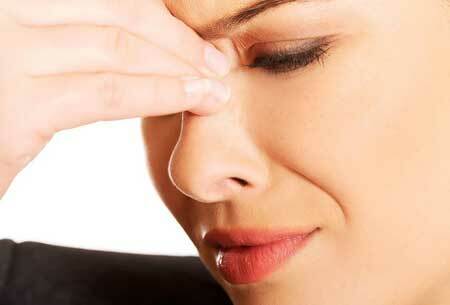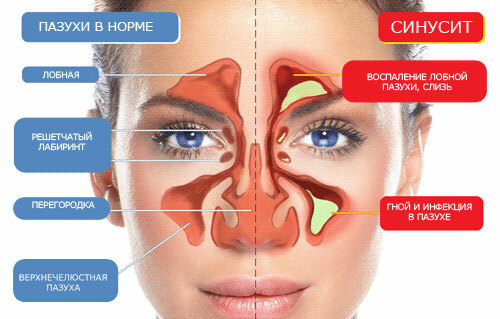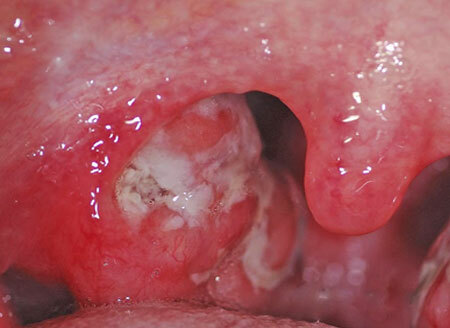Everyone knows sinusitis, but more often doctors initially diagnose sinusitis in patients. It is necessary to distinguish between these two medical terms.
Sinusitis has a variety of symptoms depending on the localization of inflammation, and treatment in adults and children may be fundamentally different.
Contents of
- 1 Sinusitis, what is it?
- 2 Symptoms of sinusitis in adults
- 3 Symptoms of sinusitis in children, features of
- 4 Methods of treating sinusitis in adults
- 4.1 Treating sinusitis at home
- 4.2 Main results: symptoms and treatment of sinusitis
Sinusitis, what is it?
Sinusitis is a medical term that generalizes the inflammatory processes in the nasal sinuses: the maxillary, frontal, wedge, and cells of the latticed bone. Sinusitis is manifested by problems with nasal breathing( nasal congestion, discharge), headaches of point or diffuse localization, common symptoms.
Each form of sinusitis has specific symptoms, according to which it is possible to assume the localization of the inflammatory process and choose the most effective treatment regimen.

Sinusitis and sinusitis: what's the difference?
Sinusitis is just one of several, often diagnosed, forms of sinusitis. The disease has a specific symptomatology. Often, with genyantritis doctors perform sinus punctures( up to 5-7 times), establish temporary drainage.
Causes of sinusitis:
- Incomplete rhinitis, acute respiratory disease, influenza, measles / scarlet fever( distinguish between bacterial sinusitis, viral, fungal);
- Changes in bone structures forming the sinuses of the nose( including congenital / traumatic deformity of the nasal septum);
- Sensitization of the body with manifestations of allergic rhinitis, including allergy to medicines;
adenoids, polyps in the nose.
Forms of sinusitis
Depending on the lesions of these or those nasal adnexa, several forms of sinusitis are distinguished:
- Sinusitis is an inflammation of the mucous membrane of the maxillary sinuses. The most commonly diagnosed in adults and children from 7 years.
- Frontite - inflammatory lesion of the frontal sinuses.
- Etomoiditis - inflammation develops in the cells of the latticed bone.
- Sphenoiditis is an inflammation of the wedge sinus( sinus).Extremely rare form, usually combined with etmoidite.
With the course of sinusitis, the sinuses of the nose are:
- acute( the course of the disease up to 8 weeks) and chronic;
- single-sided and double-sided;
- exudative( serous, catarrhal, purulent) and productive( hyperplastic, polyposis);
- is septic( infectious) and aseptic.
Symptoms of sinusitis in adults

Suspicion of the formation of an inflammatory focus in one or more accessory sinuses of the nose occurs if an adult or child has a nasal congestion observed more than 7-10 days without visible improvement. Symptoms of sinusitis in adults with acute and chronic form of the disease are different.
Symptoms of acute sinusitis
- Persistent nasal congestion;
- Mucous / purulent discharge from nasal passages;
- Cough due to flow of exudate to the pharynx( posterior wall), expectoration of abundant purulent sputum is especially strong in the mornings;
- Feeling of bursting and heaviness in the area of the inflamed sinus, especially pronounced when the head is tilted forward;
- Pain with sinusitis in the affected sinus area with possible irradiation in the teeth, eyes, cheekbones;
- Puffiness and soreness over the focus of inflammation that occurs when touching the skin;
- Weak / absent smell;
- Hyperthermia: in the acute phase up to 38.0С and above, in chronic - up to 37.5С;
- Weakness, restless sleep, lack of appetite.
Symptoms of chronic sinusitis
Symptoms of sinusitis in the chronic phase are usually scanty. The patient can note:
- Difficulty with breathing through the nose, nasal congestion, periodically appearing crusts in the nose;
- A small amount of mucous / purulent exudate, with a purulent process smelly odor from the mouth;
- Dry throat, headache, irritability.
Special clinical manifestations of of various forms of sinusitis
- Genyantritis - an increasing painfulness when the head is tilted or pressed on the area of the maxillary sinus, the nature of the pain is quite intense and constant in time, lacrimation and photophobia.
- Acute frontitis - swelling of the nose and eyes, increased pain when tapping the frontal sinuses, thick yellow / green mucus from the nose, radiating pain in the ears and teeth, relief from severe headaches occurs only in a horizontal position, a decrease in smell and taste, marked weaknessand high hyperthermia.
- Chronic frontitis - purulent sputum is abundantly allocated from the nose in the mornings after rising from bed, aching headaches.
- Acute etimoiditis is a severe condition of the patient, tenderness of nose bridge and nose, nose breathing is difficult, hyperthermia up to critical digits, vomiting / diarrhea, severe intoxication.
- Chronic etmoiditis - diffuse headaches, painful palpation of the bridge of the nose, nauseating smell of purulent discharge, thick mucus in the nasopharynx provokes constant spitting, polyps formation.
Symptoms of sinusitis in children, features of
Unlike adults, the symptoms of sinusitis in children are sufficiently oiled. The disease is most often formed against the background of sore throat or flu, often accompanied by otitis.
When examining a child, you can notice:
- breathing mouth and day, and during sleep;
- purulent exudate, flowing from the nasal passages and the back wall of the pharynx;
- sharp unpleasant odor when breathing;
- marked general symptoms - malaise, restless sleep due to nasal breathing and dry cough;
- no complaints of headache and almost always normal or subfebrile temperature;
- refusal of food.
Most often in a small child, the inflammatory process from one sinus passes to another with a predominant lesion of the sinuses of one side of the face( hemisinusitis).
Treatment methods for sinusitis in adults

The treatment regimen is administered only after confirming the diagnosis of sinusitis and determining the localization of inflammation by instrumental studies. Usually an ENT doctor prescribes a rhinoscopy, an x-ray or a computer tomography of the sinuses of the nose.
Symptomatic measures in the treatment of sinusitis in adults include:
- air humidification;
- copious drink;
- air hygiene in the room( no dust, tobacco smoke);
- high-grade food;
- exclusion of drafts and supercooling.
Medical treatment of sinusitis, drugs and antibiotics
- Anesthesia - analgesics( Analgin, Tempalgin, etc.).
- Vasodilating drops( Naphthyzine, Nazivin, Oksimetazolin) - only to reduce edema not more than 3 days. Prolonged use activates the process of atrophy of the nasal mucosa, and large doses can provoke the stopping of breathing in young children.
- Antihistamines are used only for medical purposes.
- Antibiotics for sinusitis are used only in the bacterial nature of inflammation. Effective Ampicillin, Amoxicillin, Azithromycin, Ceftriaxone. Treatment for acute sinusitis includes a course of individually selected antibiotic for a duration of 9-14 days. When catarrhal form( including fungal infection) is particularly effective local drug Fusafunzhin.
- Immunostimulants - used to prevent relapses.
Radical treatment of

Surgical treatment is indicated for severe, non-conservative treatment of sinusitis. Treatment of chronic sinusitis necessarily involves the evacuation of accumulated in the nasal sinuses of exudate.
Methods of cleansing of the sinuses:
- Puncture - puncture of the inflamed sinus and its washing with solutions of antiseptics and antibiotics( Dioxydin, Peloidin, etc.), enzyme solutions( Chymotrypsin, Lidase) with very viscous mucus. The effectiveness of antibiotics is increased when combined with Fluimutsil.
- Method of "cuckoo" - surgically, the nasal sinuses are cleaned by suction with further washing of the sinuses with antibiotics.
- The aspiration technique with the use of the catheter "Yamik" is effective in the defeat of several sinuses and only with exudative forms of inflammation.
- Endoscopic rhinosurgery - resection of the posterior part of the median nasal cone( used for sphenoiditis), elimination of polyps, septoplast( correction of nasal septum).
Treatment of sinusitis at home
All medical methods used at home are always discussed with the doctor. The treating ENT doctor can recommend:
- Rinsing the nose using a special teapot, a bottle-pulverizer or a rubber pear. Prepare a warm soda solution.
- Steam inhalation using decoction of eucalyptus, tea tree oil, mint.
Complications of sinusitis:
- Meningitis, encephalitis.
- Increase in intraocular, intracranial pressure.
- Phlegmon and abscesses, purulent melting of bone structures.
- Cavernous sinus thrombosis and sepsis.
Prevention of sinusitis
Prophylaxis of sinusitis in adults and children includes timely treatment of acute colds, elimination of chronic foci of infection in the nose and throat( polyps, adenoids, caries).
It is important to maintain the immune defenses of the body at the proper level and if not more than a week, rinite - do not hesitate, and seek the advice of an ENT doctor.
Main results: symptoms and treatment of sinusitis

- Clinic of sinusitis in children is less pronounced.
- Localization of inflammation can be determined by localization of soreness, and only by instrumental diagnostics.
- Antibiotics are prescribed only for the bacterial nature of inflammation. Transparent exudate in the nose - a sign of a viral infection, with bacterial inflammation - detachable from the nose of white, yellow, green.
- If antibiotics are ineffective, a bacteriological study and a sensitivity test for different drugs are prescribed.
- Antibiotic therapy with exudative form of sinusitis necessarily combined with evacuation of mucus from the affected sinuses( inhalation, rinsing, puncture).



